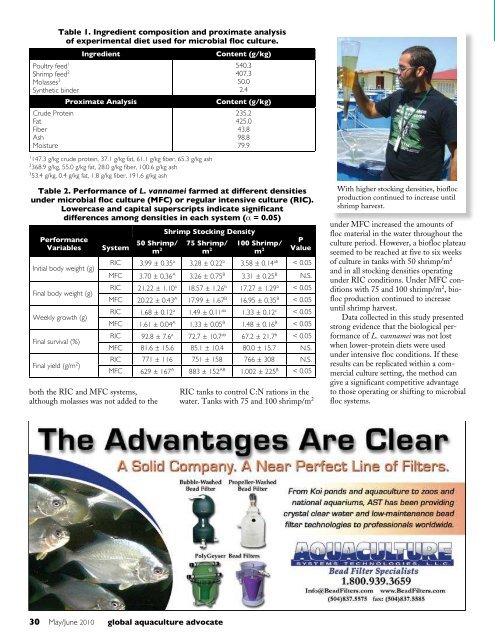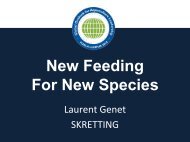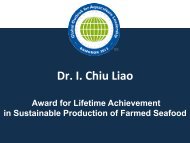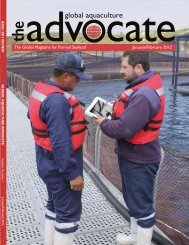May/June 2010 - Global Aquaculture Alliance
May/June 2010 - Global Aquaculture Alliance
May/June 2010 - Global Aquaculture Alliance
Create successful ePaper yourself
Turn your PDF publications into a flip-book with our unique Google optimized e-Paper software.
Poultry feed 1<br />
Shrimp feed 2<br />
Molasses 3<br />
Synthetic binder<br />
Crude Protein<br />
Fat<br />
Fiber<br />
Ash<br />
Moisture<br />
Table 1. Ingredient composition and proximate analysis<br />
of experimental diet used for microbial floc culture.<br />
Ingredient Content (g/kg)<br />
both the RIC and MFC systems,<br />
although molasses was not added to the<br />
540.3<br />
407.3<br />
50.0<br />
2.4<br />
Proximate Analysis Content (g/kg)<br />
1 147.3 g/kg crude protein, 37.1 g/kg fat, 61.1 g/kg fiber, 65.3 g/kg ash<br />
2 368.9 g/kg, 55.0 g/kg fat, 28.0 g/kg fiber, 100.6 g/kg ash<br />
3 53.4 g/kg, 0.4 g/kg fat, 1.8 g/kg fiber, 191.6 g/kg ash<br />
235.2<br />
425.0<br />
43.8<br />
98.8<br />
79.9<br />
Table 2. Performance of L. vannamei farmed at different densities<br />
under microbial floc culture (MFC) or regular intensive culture (RIC).<br />
Lowercase and capital superscripts indicate significant<br />
differences among densities in each system (α = 0.05)<br />
Performance<br />
Variables System<br />
Initial body weight (g)<br />
Final body weight (g)<br />
Weekly growth (g)<br />
Final survival (%)<br />
Final yield (g/m 2 )<br />
50 Shrimp/<br />
m 2<br />
Shrimp Stocking Density<br />
75 Shrimp/<br />
m 2<br />
100 Shrimp/<br />
m 2<br />
P<br />
Value<br />
RIC 3.99 ± 0.35 a 3.28 ± 0.22 b 3.58 ± 0.14 ab < 0.05<br />
MFC 3.70 ± 0.36 A 3.26 ± 0.75 B 3.31 ± 0.25 B N.S.<br />
RIC 21.22 ± 1.10 a 18.57 ± 1.26 b 17.27 ± 1.29 b < 0.05<br />
MFC 20.22 ± 0.43 A 17.99 ± 1.67 B 16.95 ± 0.35 B < 0.05<br />
RIC 1.68 ± 0.12 a 1.49 ± 0.11 ab 1.33 ± 0.12 c < 0.05<br />
MFC 1.61 ± 0.04 A 1.33 ± 0.05 B 1.48 ± 0.16 B < 0.05<br />
RIC 92.8 ± 7.6 a 72.7 ± 10.7 ab 67.2 ± 21.7 b < 0.05<br />
MFC 81.6 ± 15.6 85.1 ± 10.4 80.0 ± 15.7 N.S.<br />
RIC 771 ± 116 751 ± 158 766 ± 308 N.S.<br />
MFC 629 ± 167 A 883 ± 152 AB 1.002 ± 225 B < 0.05<br />
RIC tanks to control C:N rations in the<br />
water. Tanks with 75 and 100 shrimp/m 2<br />
With higher stocking densities, biofloc<br />
production continued to increase until<br />
shrimp harvest.<br />
under MFC increased the amounts of<br />
floc material in the water throughout the<br />
culture period. However, a biofloc plateau<br />
seemed to be reached at five to six weeks<br />
of culture in tanks with 50 shrimp/m2 and in all stocking densities operating<br />
under RIC conditions. Under MFC conditions<br />
with 75 and 100 shrimp/m2 under MFC increased the amounts of<br />
, biofloc<br />
production continued to increase<br />
until shrimp harvest.<br />
Data collected in this study presented<br />
strong evidence that the biological performance<br />
of L. vannamei was not lost<br />
when lower-protein diets were used<br />
under intensive floc conditions. If these<br />
results can be replicated within a commercial<br />
culture setting, the method can<br />
give a significant competitive advantage<br />
to those operating or shifting to microbial<br />
floc systems.<br />
production<br />
Bioreactor Technology For Tilapia<br />
Advances In Latin America<br />
The construction of V-shaped commercial bioreactors inside plastic tunnel greenhouses<br />
began in 2000.<br />
Summary:<br />
Continued research and development<br />
on tilapia culture is leading<br />
to further advances in production<br />
technology. Early biofloc-based<br />
culture systems in tanks in Brazil<br />
have given way to commercialscale<br />
bioreactors housed in greenhouses<br />
that utilize water fertilization<br />
regimes, high-protein feeds<br />
and salinity controls. Survival<br />
and feed conversion have been<br />
excellent, although growth rates<br />
are less consistent than in more<br />
traditional systems.<br />
The first experiments with tilapia bioflocs<br />
in subtropical southern Brazil were<br />
conducted in September 1998 using procedures<br />
similar to those the Oceanic<br />
Institute concept of mesocosms, aquatic<br />
controlled (MAC), applied to Litopenaeus<br />
vannamei shrimp.<br />
The first experimental units were 20<br />
200-L plastic indoor tanks with aeration,<br />
into which Oreochromis niloticus larvae<br />
were stocked at densities of 1-10/L. An<br />
objective was to overwinter them in commercial<br />
units at low cost.<br />
The survival and feed-conversion<br />
ratios for fish at all densities were exceptionally<br />
good compared to the performance<br />
achieved using previously available<br />
techniques. However, growth was low,<br />
especially compared to shrimp produced<br />
in similar bacteria-based systems in<br />
Hawaii, USA, and Belize.<br />
Greenhouse Bioreactors<br />
The preliminary results motivated in<br />
early 2000 the construction of commercial<br />
1,000-m 3 V-shaped bioreactors inside two<br />
800-m 2 plastic tunnel greenhouses. The<br />
aim of the units was to overwinter 300,000<br />
1-g tilapia fry purchased inexpensively at<br />
the end of the growout season in late <strong>May</strong><br />
and sell large juveniles of up to 20 g at top<br />
prices in September, just before the breeding<br />
season.<br />
The results of this first commercial<br />
trial quickly changed when the fish grew<br />
to the targeted 20-g size in the first 40<br />
days, so it was impossible to sell them as<br />
juveniles 90 days later. The fish were kept<br />
growing with 25% of the forecasted feed<br />
in order to check the carrying capacity of<br />
the reactors and the growth curve up to<br />
market size.<br />
The fish attained commercial size in<br />
150 days with an average feed-conversion<br />
ratio of 0.77 and survival of 92%. However,<br />
the size variation was very large, and<br />
some fish grew 500 g in less than four<br />
months. While external temperatures<br />
averaged 5 to 10° C, water temperatures<br />
inside the greenhouses were never below<br />
28° C, and the floc was very stable and<br />
always dark green.<br />
The major changes to the MAC environment<br />
in these initial floc trials was the<br />
Sergio Zimmermann<br />
Akvaforsk Genetics Center A.S.<br />
N-6600 Sunndalsøra, Norway<br />
sergio.zimmermann@afgc.no<br />
higher water temperatures and the presence<br />
of plankton influenced by the sunlight<br />
in the greenhouse.<br />
Expansion, Invention<br />
By 2004, the project had 21 tilapia<br />
bioreactors and 16 commercial growout<br />
facilities in southern Brazil. One facility<br />
in Colombia was dedicated to mesocosm<br />
culture of first-feeding carnivorous larvae.<br />
Several in Ecuador and Angola handled<br />
nursery-phase tilapia juveniles.<br />
Over the years, several protocols were<br />
developed. A water fertilization regime<br />
aimed at proper balancing of carbon,<br />
nitrogen and phosphorus levels to favor<br />
chlorophytes and avoid cyanophyte<br />
blooms. High-protein feeds were used to<br />
achieve excellent feed conversion. Salinity<br />
controls that favor inland polyculture<br />
with white shrimp were established to<br />
improve the taste of both tilapia and<br />
shrimp.<br />
Recently, Storvik and Akvaforsk<br />
Genetics Center A.S. tested the effects<br />
of liquid oxygen at the FishSul facilities<br />
with promising results. The commercialization<br />
of tilapia culture in bioreactors is<br />
becoming a marketing success, with no<br />
diseases or water exchange reported over<br />
the last 10 years.<br />
Biofloc technology is an integral part of<br />
the ongoing development.<br />
30 <strong>May</strong>/<strong>June</strong> <strong>2010</strong> global aquaculture advocate global aquaculture advocate <strong>May</strong>/<strong>June</strong> <strong>2010</strong> 31





